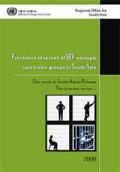Publications - Released in 2008
Worldwide at any given time, there are approximately 10 million prison inmates, with an annual turnover of 30 million. Thus, after release, millions of prisoners return to social networks in the general community, thereby facilitating the spread of HIV to the community.
Prison inmates are vulnerable to risk behaviours including drug abuse and HIV. Although no reliable estimates are available for the South Asian region, in most countries, drug use and unsafe sexual practices are well-recognized problems in prison settings.
Everywhere in the world, rates of HIV-infection among prison populations are generally much higher than in the general population. Drug use in general, and injecting drug use in particular, as well as violence and the practice of men having sex with men are widespread in prisons.
In South Asia (Bangladesh, India, Maldives, Nepal and Sri Lanka), 26 prison intervention sites
are being supported by UNODC under its regional project RAS/H71 titled, "Prevention of spread of HIV amongst vulnerable groups in South Asia".
Downloads
Organizations
- United Nations Office on Drugs and Crime (UNODC)






